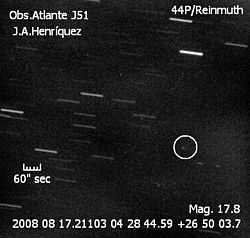44P/Reinmuth
 | |
| Discovery | |
|---|---|
| Discovered by | Karl Reinmuth[1] |
| Discovery date | 10 September 1947 |
| Alternative designations |
1947 VII, 1954 VI, 1960 IX, 1974 VI, 1981 III, 1987 XXVI, 1994 XVII |
| Orbital characteristics A | |
| Epoch | February 17, 2013 |
| Aphelion | 5.2693 AU[1] |
| Perihelion | 2.1161 AU[1] |
| Semi-major axis | 3.6928 AU[1] |
| Eccentricity | 0.42693[1] |
| Orbital period | 7.1 a[2] |
| Inclination | 5.8954°[1] |
| Last perihelion | 20 February 2001[3] |
| Next perihelion | 24 March 2015[3] |
44P/Reinmuth or Reinmuth 2 is a Jupiter-family comet that is greatly perturbed by the gas giant Jupiter.[2] The diameter of this comet is estimated at 3.22 km and its absolute magnitude at 11.[1]
Discovery

Reinmuth was discovered during a survey of small Solar System bodies with the 40 cm Bruce telescope at the LSW-Heidelberg Observatory in Heidelberg, Germany. The absolute magnitude of the comet was estimated by Karl Reinmuth to be 13, two orders of magnitude smaller than the current estimate.[2]
This comet was found to be a periodic comet by Leland E. Cunningham in Berkeley, California, who calculated an elliptical orbit with a 7.12-year orbital period. He also predicted that it would come to perihelion again on October 3, 1947. Later, this was revised to 6.59 years and August 19, 1947. The comet ended up reaching perihelion nearly one month after the expected date, and the calculations of its orbit was then refined further until the values were correct.[2]
Relationship with Jupiter

Reinmuth makes many close approaches to Jupiter. These close approaches gradually change its orbit. For example, on July 16, 2003, comet Reinmuth came within 0.74144 AU of Jupiter.[1] This increased its perihelion from 1.89 to 2.11 AU and its orbital period from 6.63 to 7.07 years.[2] On February 11, 2039, Reinmuth will come within 0.52431 AU of Jupiter, which will raise its perihelion to 2.44 AU and its orbital period to 7.78 years.[2] On July 21, 2063 and March 1, 2146, Reinmuth will come 0.43878 AU and 0.51895 AU, respectively.[1] Close approaches like these could raise Reinmuth's perihelion until it ceases to become a comet.
References
- ↑ 1.0 1.1 1.2 1.3 1.4 1.5 1.6 1.7 1.8 "44P/Reinmuth orbit diagram". JPL Small-Body Database. Jet Propulsion Laboratory. SPK-ID: 1000071.
- ↑ 2.0 2.1 2.2 2.3 2.4 2.5 Kronk, Gary. "44P/Reinmuth 2". Gary W. Kronk's Cometography. Retrieved 2013-10-18.
- ↑ 3.0 3.1 Yoshida, Seiichi (April 29, 2013). "44P/Reinmuth". Retrieved 20 October 2013.
| Periodic comets (by number) | ||
|---|---|---|
| Previous 43P/Wolf-Harrington |
44P/Reinmuth | Next 45P/Honda-Mrkos-Pajdusakova |

